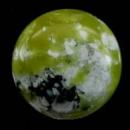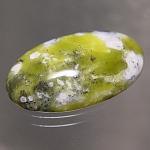|
|
||||||||||||||||
|
||||||||||||||||
|
||||||
|
|
|
|
Lizardite
|
|
| | |
| Discovered in 1956; IMA status: Valid (pre-IMA; Grandfathered) | ||
|
| ||
|
Chemistry |
|
|
| |
|
Mg3Si2O5(OH)4 | |
|
|
Magnesium Silicate Hydroxide |
|
Molecular Weight: |
277.11 gm |
|
Composition: |
Magnesium |
26.31 % |
Mg |
43.63 % |
MgO |
|
|
Silicon |
20.27 % |
Si |
43.36 % |
SiO2 |
|
|
Hydrogen |
1.45 % |
H |
13.00 % |
H2O |
|
|
Oxygen |
51.96 % |
O |
|
|
|
|
|
100.00 % |
|
100.00 % |
= TOTAL OXIDE |
|
|
|
||||
|
Classification |
|
|
| |
|
Silicates (Germanates) | |
|
8/H.27-20 | |
|
|
9 : SILICATES (Germanates)
|
|
Related to: |
Serpentine Group (subgroup of the Kaolinite-Serpentine Group). Polymorphous with Antigorite and Chrysotile. Forms a series with Népouite. |
|
Members of Group: |
Serpentine Group:
Antigorite, Chrysotile, Lizardite. |
|
Varieties: |
Scyelite |
|
Synonyms: |
Al-lizardite, Baumite, Nickeloan Lizardite |
|
|
|
|
Crystal Data |
|
|
|
|
|
Crystals rare, to 2 mm, as trigonal plates to truncated trigonal pyramids. Commonly as extremely fine-grained scales and massive aggregates. |
|
|
None |
|
|
|
|
|
Physical Properties |
|
|
|
|
|
Perfect on {0001} |
|
|
n/a |
|
|
Crystals are easily bent |
|
|
2.50 |
|
|
2.55 (g/cm3) |
|
|
None |
|
|
Not Radioactive |
|
|
|
|
|
Optical Properties |
|
|
|
|
|
Green, light yellow to white; colorless to pale green in thin section |
|
|
Translucent |
|
|
Waxy |
|
|
1.538 - 1.568 Uniaxial ( - ) to slightly Biaxial ( - ) |
|
|
0.012 |
|
|
Weak to distinct |
|
|
n/a |
|
|
|
|
|
Occurances |
|
|
|
|
|
Geological Setting: |
Typically a product of retrograde metamorphism, replacing olivine, orthopyroxene, or other minerals in ultramafic igneous rocks. |
|
Common Associations: |
Chrysotile, Brucite, Magnetite |
|
Common Impurities: |
n/a |
|
Type Locality: |
Eastern Cliff, Kennack Cove (Kennack Sands), Kennack, Grade-Ruan, Lizard Peninsula, Cornwall, England, UK |
|
Year Discovered: |
1956 |
|
View mineral photos: | |
|
|
|
|
More Information |
|
|
|
|
|
| |
|
|
|
|
Lizardite
distribution: Probably the most common serpentine mineral.
A few prominent localities for well-studied material
include: at Kennack Cove, The Lizard, Cornwall, England.
On Unst, Shetland Islands, Scotland. From near Val Sissone,
Lombardy, and Val Trebbia, Piacenza, Italy. In Japan,
from Maruo Odori and Kodo, Yamaguchi Prefecture, and
at Hamao, Fukuoka Prefecture. At Woodsreef, New South
Wales, Australia. From the Jeffrey mine, Asbestos, Quebec,
and the Cassiar mine, British Columbia, Canada. In the
USA, at the Stillwater complex, Montana. |
|
|
|||||||||||||||||||||||||||


